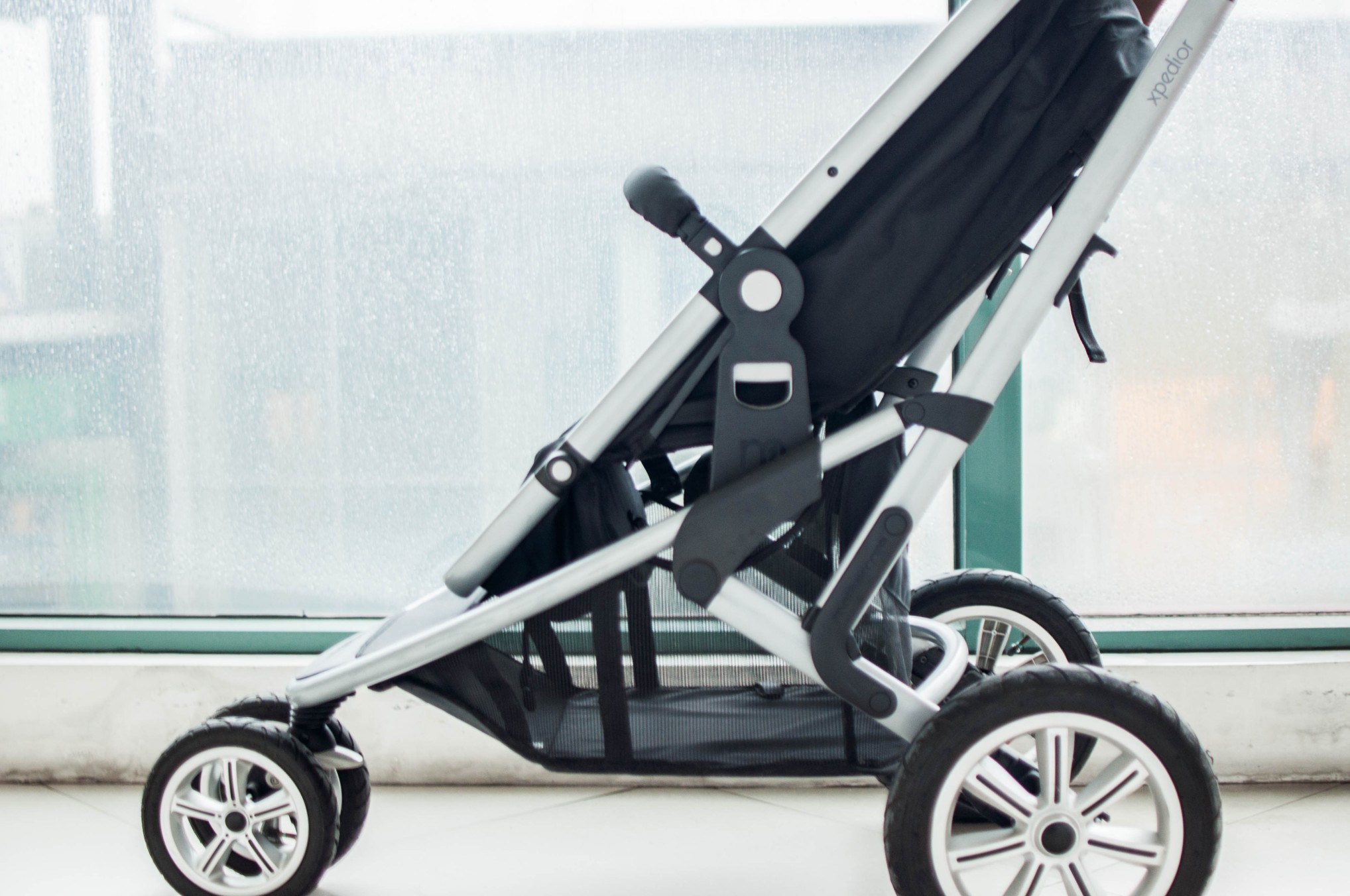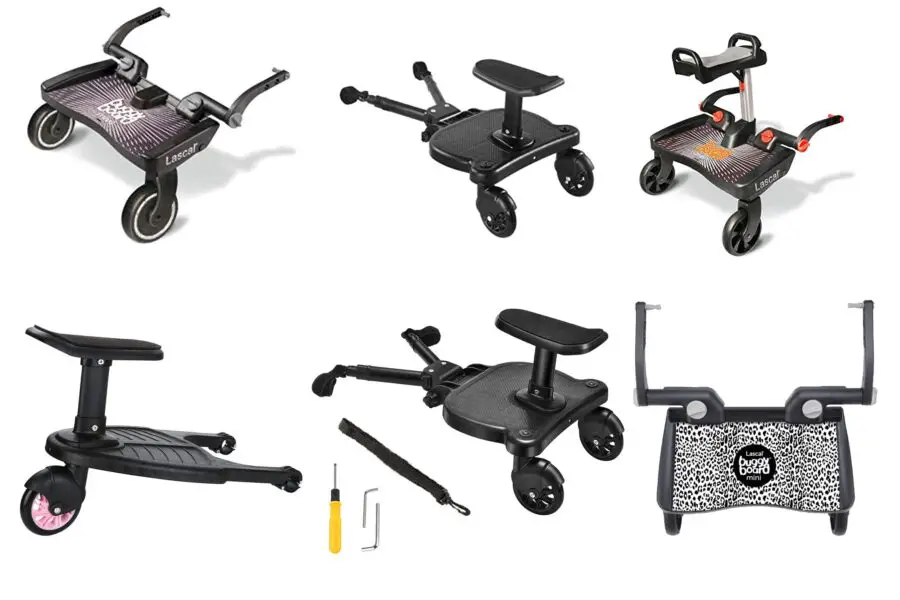- Daily: Quick visual checks and wipe-downs.
- Weekly: Clean thoroughly and inspect wheels.
- Monthly: Inspect all parts and lubricate moving components.
Why it Matters:
- Safety First: A well-maintained frame prevents rust, misaligned wheels, and loose parts.
- Save Money: Proper care can retain 40–60% of your stroller's resale value.
- Adapt to Conditions: Urban use? Check brakes often. Coastal areas? Fight salt corrosion.
Tools You’ll Need:
- Screwdrivers, wrenches, hex keys, and cleaning supplies like microfiber cloths and silicone-based lubricants.
- Material-specific care items (e.g., rust inhibitors for steel, UV protectant for composites).
Quick Fixes:
- Tighten loose bolts, treat rust early, and straighten minor frame bends (if safe to do so).
For deeper issues like cracks or severe rust, consult a professional. Follow this guide to keep your buggy safe, functional, and ready for years of use.
Edwards & Co Servicing Guide | How to service your stroller
Required Tools and Supplies
Having the right tools on hand makes maintaining your buggy frame much simpler. With a well-prepared maintenance kit, you can tackle minor issues before they turn into bigger problems.
Basic Tools List
Here are the essentials every parent should have for routine buggy maintenance:
Core Tools:
- Phillips and flathead screwdrivers in various sizes
- Adjustable wrench
- Hex/Allen key set (both metric and imperial)
- Digital torque screwdriver for accurate tightening
Cleaning Supplies:
- Mild dish soap mixed with warm water
- Microfiber cloths for wiping surfaces
- Soft-bristled toothbrush for detailed cleaning
- Cotton swabs to reach tight spaces
- Spray bottle to apply your cleaning solution
Maintenance Materials:
- Silicone-based lubricant for moving parts
- Metal polish specific to your buggy's frame
- Rust inhibitor for steel frames
Keeping these tools and supplies in a dedicated kit ensures regular maintenance is hassle-free and helps prolong the life of your buggy. Remember, some buggy models or materials may require additional specialized tools.
Special Tools Guide
Certain buggy models and frame materials need more specific tools for proper care:
Frame-Specific Tools:
- Torx bits (commonly in T10–T30 sizes)
- Security bits for tamper-resistant screws
- Rubber mallet for alignment adjustments
- Medium-strength thread-locking compound
Safety Equipment:
- Nitrile or latex gloves
- Safety glasses
- Dust mask (especially when addressing rust)
- LED headlamp or adjustable desk lamp for better visibility
- Magnetic parts tray to keep screws and small items secure
Material-Specific Tools:
| Frame Type | Special Tools | Supplies Needed |
|---|---|---|
| Aluminum | Non-abrasive metal polish | Aluminum-safe lubricant |
| Steel | Fine-grit sandpaper (400–600 grit) | Rust converter |
| Composite | UV protectant spray | Plastic-safe cleaners |
To stay organized, store your maintenance kit in a cool, dry toolbox. Additionally, consider keeping a smaller “quick fix” kit in your buggy for unexpected repairs on the go.
Frame Inspection Guide
Regular frame inspections are key to keeping your buggy safe and durable. By spotting issues early, you can prevent costly repairs and ensure everything works as it should. Use this guide to check your buggy frame during monthly maintenance.
30-Day Checklist
Every 30 days, go through these steps to keep your buggy in top shape:
Frame Structure
- Apply pressure to different parts of the frame to test its stability.
- Look closely at welding points for any signs of separation or stress.
- Check the frame tubes for dents, bends, or cracks.
- Make sure the handlebar is secure and its adjustment mechanisms work properly.
Moving Components
- Test folding mechanisms to ensure they operate smoothly.
- Confirm that all locking mechanisms fully engage.
- Check that the wheels are properly aligned and securely attached.
- Test brake engagement, especially on inclined surfaces.
Connection Points
- Tighten any loose screws and bolts.
- Inspect hinges to ensure they move smoothly.
- Look for wear marks around joint areas.
- Confirm the frame’s stability under a typical load.
Spotting Damage Signs
Routine checks are essential, but you should also watch for specific warning signs that may indicate damage:
| Warning Sign | What to Look For | Required Action |
|---|---|---|
| Unusual Sounds | Squeaking or creaking during use | Inspect joints and apply lubricant as needed. |
| Visual Indicators | Hairline cracks near welds, discolored paint | Stop using the buggy and get a professional inspection. |
| Movement Issues | Difficulty folding/unfolding, loose parts | Tighten all connection points and re-check movement. |
| Surface Changes | Bubbling paint, rust around screws | Clean the area and treat any rust immediately. |
Material-Specific Inspection Tips
Different frame materials require specific attention:
- Aluminum Frames: Check for fine stress lines near joints, white powdery corrosion, and unusual dents.
- Steel Frames: Look for rust (orange-brown spots), paint bubbling or flaking, and deep scratches that expose bare metal.
- Composite Frames: Watch for stress whitening, surface cracks or spider-web patterns, and any unexpected flexibility.
Tools for Hard-to-See Areas
To inspect areas that are hard to reach, try these tools:
- An LED flashlight for dark or recessed spots.
- A small mirror on an extendable handle for tight angles.
- A magnifying glass to spot tiny cracks.
- Your smartphone camera to document and examine issues up close.
If you live in a coastal area or a place with high humidity, consider bumping up your inspection frequency to every two weeks. And after any collision or heavy impact, make it a priority to thoroughly inspect the frame before using it again.
Simple Frame Repairs
After identifying issues during your inspection, it's time to tackle some straightforward fixes. These methods will help restore stability and extend the life of your frame.
Fixing Loose Parts
If you notice rattling sounds or wobbly joints during your check, here's what you can do:
- Clean bolts and connection points thoroughly to remove dirt or debris.
- Use tools that fit properly to tighten bolts, being careful not to overtighten.
- For bolts under high stress, apply a thread-lock adhesive to keep them secure.
- Allow the adhesive to cure fully as per the instructions before using the frame again.
If a bolt keeps loosening, take a closer look at the surrounding area. There could be wear or damage that needs attention.
Rust Treatment Steps
Catching rust early is key to avoiding long-term damage. Here’s a step-by-step guide:
- Initial Cleaning
Start by cleaning the rusted area with warm, soapy water. Dry the surface completely to prevent further corrosion. - Rust Removal
Depending on the severity, try these methods:- For light rust:
- Mix baking soda and water into a paste.
- Spread it over the rusted spots and let it sit.
- Gently scrub with fine steel wool, then wipe clean and dry thoroughly.
- For stubborn rust:
- Apply white vinegar directly to the rust.
- Let it sit for some time.
- Scrub using a wire brush in circular motions.
- Rinse and dry the area completely.
- For light rust:
- Protection
Once the rust is removed, apply an anti-rust spray or protective wax. This will create a barrier against moisture and help prevent future rust.
Frame Straightening Tips
After dealing with rust, you may need to straighten minor bends in the frame to ensure proper alignment. Before starting, make sure to:
- Wear safety gear like gloves and protective glasses.
- Remove any accessories and work on a stable, flat surface.
The straightening method depends on the frame material:
| Frame Material | Recommended Approach | When to Stop |
|---|---|---|
| Aluminum | Apply gentle, even pressure without using heat. | Stop if you notice stress marks or cracks. |
| Steel | Use controlled heat with a heat gun to aid bending. | Stop if you see discoloration or warping. |
| Composite | Straightening is not recommended. | Any visible stress marks indicate further damage. |
For minor adjustments:
- Use padded clamps to distribute pressure evenly.
- Apply gradual force and check your progress frequently.
- Once straightened, test the frame's stability before reattaching any accessories.
These simple repairs can go a long way in maintaining your frame's integrity and ensuring it performs as expected.https://app.seobotai.com/banner/inline/?id=sbb-itb-edcd6d4
Professional Repair Guide
Some stroller issues are easy to handle at home, but others demand the expertise of a professional.
Fix or Replace Decision
Use the table below to assess whether you can tackle the problem yourself or if professional assistance is required:
| Issue Type | DIY-Safe | Needs Professional Help |
|---|---|---|
| Surface Issues | Minor scratches, scuffs | Deep gouges that compromise the structure |
| Loose Parts | Tightening bolts | Damaged threading or stripped screws |
| Rust | Light surface rust | Deep rust affecting frame integrity |
| Frame Alignment | Small wheel adjustments | Bent frame sections |
| Structural Issues | None | Cracks, breaks, or damaged welds |
When to call a professional:
- Persistent squeaking or grinding even after lubrication.
- Folding mechanisms that fail to lock securely.
- Cracks, breaks, or visible damage to the frame.
- Wheel axles that cause misalignment.
- Issues with welded joints.
Expect repair costs to range between $30 and $200. If the cost of repairs exceeds 50% of the stroller's value, it's usually better to replace it. Also, make sure to check your warranty before committing to any repairs.
Using Your Warranty
Before spending money on repairs, confirm whether your warranty covers the issue. Many manufacturers provide warranties lasting 1–3 years for manufacturing defects. Follow these steps to file a claim:
- Gather Documentation
Collect clear photos of the issue, your proof of purchase, and the stroller's serial number. - Detail the Problem
Prepare a description that includes:- When the issue began.
- How the problem occurred.
- Maintenance history.
- Typical usage conditions.
- Contact the Manufacturer
Submit your claim promptly, including all necessary documentation and details about the issue.
Choosing a Repair Service
When selecting a repair service, ask these key questions:
- Are you an authorized repair center?
- Do you use genuine parts from the manufacturer?
- What testing is done after repairs?
- Is there a warranty for the repair work?
Reputable repair services typically offer a 30–90 day warranty. Authorized centers can handle simple fixes in 1–3 days and more complex structural repairs in 7–14 days.
Frame Material Care
Once you've tackled basic repairs, it's time to fine-tune your maintenance routine based on your frame's material. Each type of frame requires specific care to keep it in top shape and performing well over time.
Aluminum Frame Care
Aluminum frames are lightweight and sturdy, but they still need regular attention. Clean your frame weekly using a soft, damp cloth and a bit of mild soap, giving extra care to joints and connection points. If you've been near saltwater – like at the beach – rinse the frame with fresh water to remove any salt residue, then dry it thoroughly with a microfiber cloth. For smooth operation, apply a small amount of silicone lubricant to hinges, folds, and wheel axles. Every few months, use an aluminum protectant spray to safeguard the surface, and cover up any scratches promptly with aluminum-compatible touch-up paint.
Steel Frame Care
Steel frames are known for their durability, but they can be prone to rust without proper upkeep. After each use, check for paint chips or scratches that could expose the metal underneath. Perform a detailed rust inspection once a month. If the frame gets wet from rain or snow, dry it immediately to prevent corrosion. Here’s a quick breakdown of essential maintenance tasks:
| Maintenance Task | Frequency | Products Needed |
|---|---|---|
| Basic Cleaning | Weekly | pH-neutral soap, soft cloth |
| Rust Inspection | Monthly | None |
| Protective Wax | Quarterly | Metal-specific wax |
| Joint Lubrication | Every 1-2 months | Lithium-based grease |
For scratches or chips, apply touch-up paint within 24 hours to prevent rust. Store your buggy in a dry, climate-controlled area to keep it in excellent condition.
Composite Frame Care
Frames made from composite materials like carbon fiber or high-grade plastics need extra protection from environmental factors. Clean these frames with a soft cloth and mild soap mixed with water, avoiding any harsh chemicals that could damage the surface. Regularly apply a UV protectant designed for plastics, especially if the stroller is often exposed to sunlight. Keep the frame out of extreme temperatures – don’t leave it in a hot car or a freezing garage. Inspect it regularly for fine cracks, which can develop over time.
General Storage Tips
Regardless of the frame material, always store your buggy in a dry, temperature-controlled space. If possible, keep it unfolded to reduce stress on the joints and hinges. By tailoring your care routine to your frame’s specific needs, you’ll ensure it stays safe, reliable, and ready for use.
Summary
Let’s wrap up the key points from the repair and inspection guidance we covered earlier. Regular check-ups and material-specific care are crucial for keeping your buggy frame in top shape.
Essential Maintenance Schedule
Here’s a quick maintenance schedule to keep your buggy running smoothly:
| Timeframe | Key Tasks | Tools Needed |
|---|---|---|
| Weekly | Clean and check joints | Soft cloth, mild soap |
| Monthly | Inspect thoroughly, lubricate | Silicone lubricant, toolkit |
| Quarterly | Protect frame, check for rust | Material-specific protectant |
Stick to this schedule to handle small issues before they grow into bigger problems. Decide whether to fix things yourself or call in a professional based on the task.
When to DIY vs. Seek Professional Help
You can confidently handle routine tasks like:
- Tightening screws and bolts
- Cleaning with soap and water
- Lubricating joints and wheel axles
- Treating minor rust spots early
However, leave the following to the experts:
- Cracks or severe bends in the frame
- Structural issues near joints
- Advanced rust that threatens the frame’s strength
- Any repairs that might fall under your warranty
Make it a habit to inspect your buggy monthly, or more often if it’s exposed to tough conditions.
Material-Specific Care
Different frame materials need different care:
- Aluminum Frames: Keep them dry to avoid oxidation.
- Steel Frames: Prioritize rust prevention.
- Composite Frames: Look out for fine cracks or splintering.
Finally, store your buggy in a dry, temperature-controlled space to maximize its lifespan. A little care goes a long way!
FAQs
×
How can I tell if my buggy frame needs professional repair instead of a DIY fix?
If you're wondering whether your buggy frame needs professional repair, start by checking for obvious signs of damage. Look for cracks, bent sections, or loose joints. If the buggy feels wobbly, makes strange noises, or doesn't fold or lock as it should, it’s probably time to seek help from a professional. Steer clear of DIY repairs if the issue involves crucial safety elements like the brakes or the frame's overall structure.
For smaller problems, like loose screws or surface scratches, you can often handle them yourself. That said, if you're unsure or the buggy is still under warranty, reaching out to the manufacturer or a certified repair service is the smarter and safer option.×
How can I protect my steel buggy frame from rust, especially if I live near the coast?
To keep a steel buggy frame free from rust, especially in coastal areas where salty air speeds up corrosion, here’s what you can do:
- Clean it often: Use a damp cloth to wipe off salt, dirt, and debris. Add a bit of mild soap if needed, and make sure to dry it completely to avoid moisture lingering on the frame.
- Use a protective coating: Apply a rust-resistant spray or wax to form a barrier against corrosion. Reapply regularly, particularly after cleaning sessions.
- Store it indoors: When the buggy isn’t in use, keep it in a dry, covered spot to reduce contact with humidity and salty air.
These simple steps can go a long way in keeping your buggy in great shape and ready to roll for years to come.×
How often should I check and maintain my buggy frame if I use it in different environments, like city streets or coastal areas?
It's wise to check your buggy frame every 1-2 months, especially if you use it regularly in different environments. In cities, your buggy might face dirt, debris, and bumpy paths. Near the coast, salt and moisture can creep in, potentially causing rust or corrosion.
If you’re using your buggy heavily or in tougher conditions, you may want to clean and inspect it more often. Focus on the moving parts, joints, and wheels during your checks. Regular upkeep ensures your buggy remains safe and reliable for your child.



